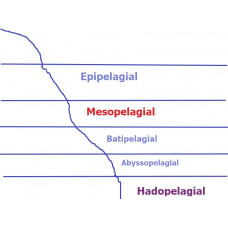Pelagial (from Greek πέλαγος - sea), the water column of oceans, seas and lakes (from the surface to the bottom). Several layers are distinguished in the ocean water column, depending on the degree of light. For example, epipelagial, mesopelagial, etc.
Mesopelagial is an oceanic zone of vertical distribution of the water column, extending from 200-meter depth to 1000 m. In tropical waters, the mesopelagial is occupied by the main thermocline layer, outside the tropics by intermediate warm and cold layers.
The mesopelagic zone (Greek μέσον, middle), also known as the middle pelagic or crepuscular zone, is the part of the pelagic zone that lies between the photic epipelagic and aphotic bathypelagic zones. It is determined by illumination and begins at a depth where only 1% of incident light reaches and ends where there is no light; the depths of this zone are approximately 200 to 1,000 meters below the ocean surface.
The mesopelagic zone occupies about 60% of the planet's surface and about 20% of the ocean volume, making up a significant portion of the entire biosphere. It is home to a diverse biological community including bristle-toothed fish, blob fish, bioluminescent jellyfish, giant squid and many other unique organisms adapted to life in low-light conditions.
Mesopelagial
Tags: mesopelagial

